The Moto E (2015) Review
by Brandon Chester on April 21, 2015 8:00 AM EST- Posted in
- Smartphones
- Motorola
- Mobile
- Moto E (2015)
CPU Performance
The 2015 Moto E with LTE is the first device with Snapdragon 410 that we've run through our tests. However, buyers of the 3G versions will only get a quad core Snapdragon 200 with 4 Cortex A7 cores. While this is still an improvement over the original, it's quite a disappointment when compared to the LTE edition. To be clear, the results below are from the Snapdragon 410 version, not the Snapdragon 200 version.
Qualcomm's MSM8916 is a quad core Cortex A53 part. Motorola's implementation has it running with a peak CPU core frequency of 1.2GHz, and it's paired with a 400MHz Adreno 306 GPU. Like the Cortex A7 cores used in Snapdragon 410, Cortex A53 is still a dual-issue in-order design, and pipeline depth remains the same as well. ARM has greatly improved branch prediction accuracy and expanded how instructions can be co-issued with Cortex A53, and so much of the performance increase over Cortex A7 will come from those improvements.

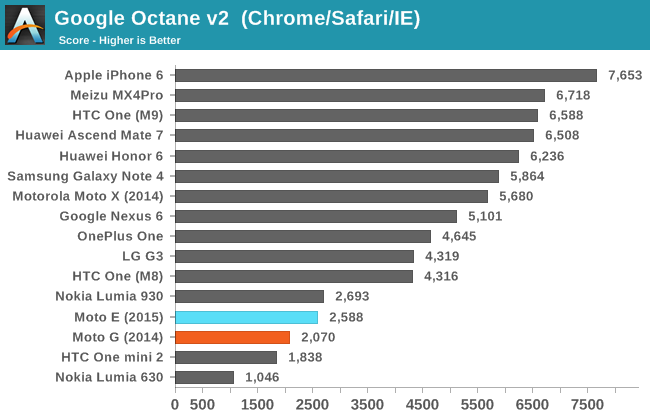
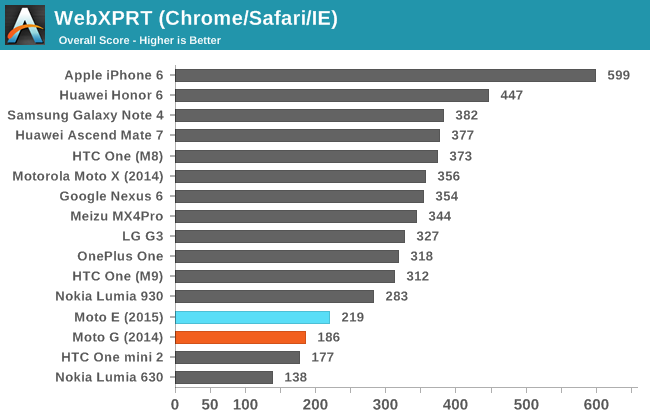
The Moto E shows a decent improvement over Snapdragon 400 based devices like the Moto G, and the improvement over the original Moto E would be even larger. That being said the Moto E doesn't do quite as well as one might expect in our browser tests. Browser optimizations play no small part in this, with Chrome having lagged behind the stock browser from other manufacturers for some time now. Motorola's devices use Chrome as their default browser, and I have a feeling that to an extent the Moto E is limited by software here rather than hardware.
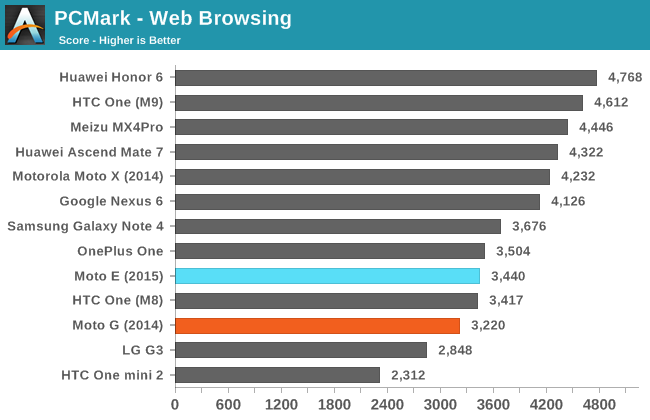

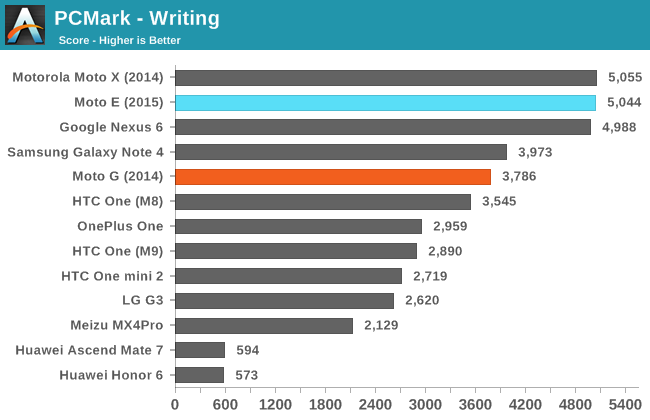
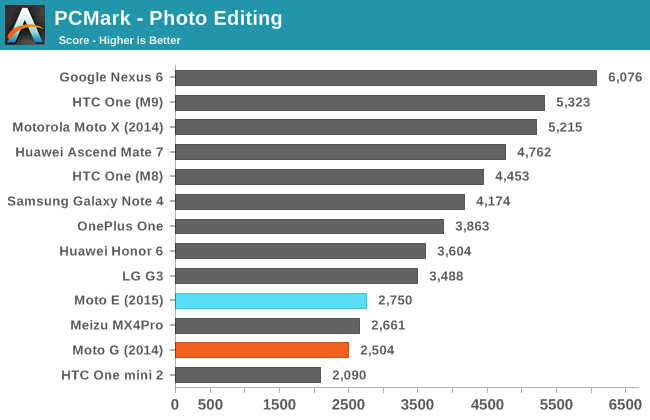
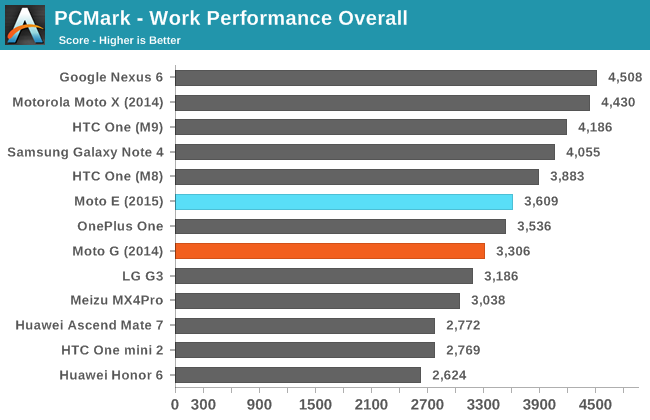
PCMark is a benchmark that focuses more on real-world scenarios where race to sleep speed is paramount. In it we see another modest overall lead compared the Moto G. The writing test in particular shows a great deal of improvement, while the video playback test is slightly worse which I suspect is the result of the Moto E's flash storage speeds causing video seek times to be longer than the Moto G.
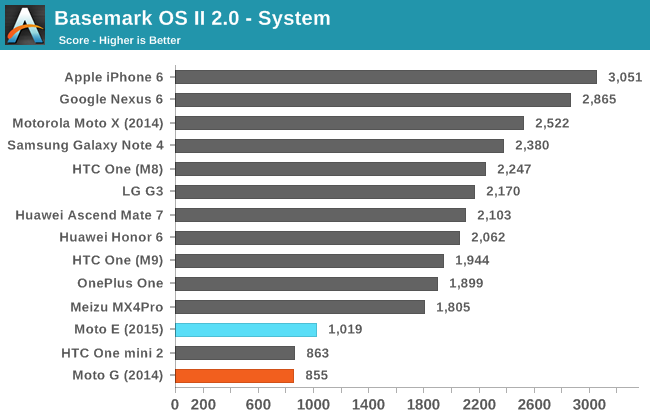
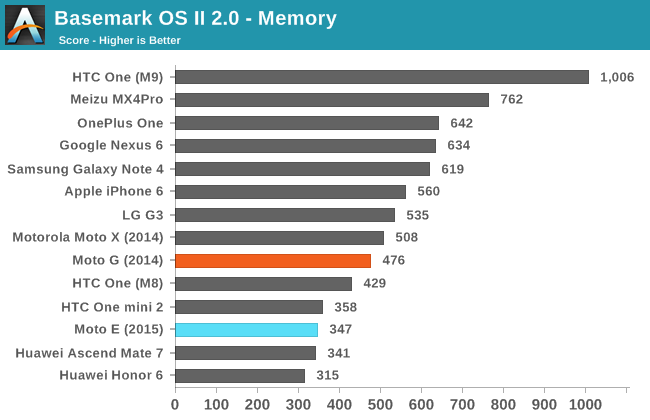
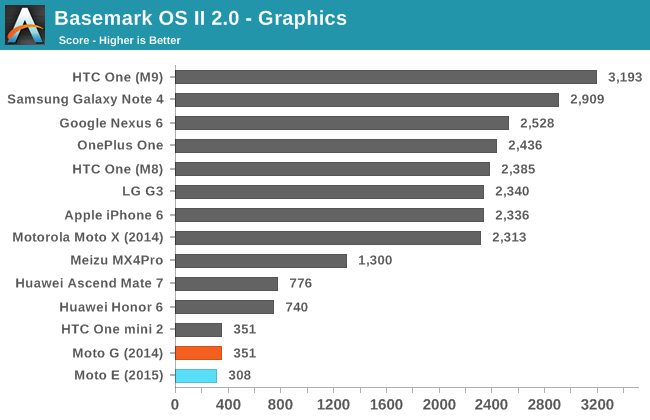
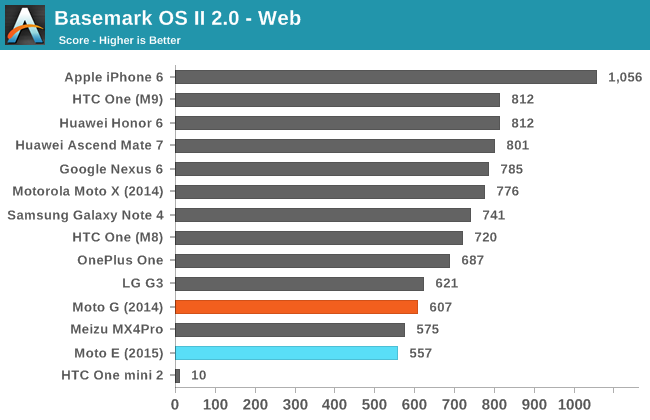
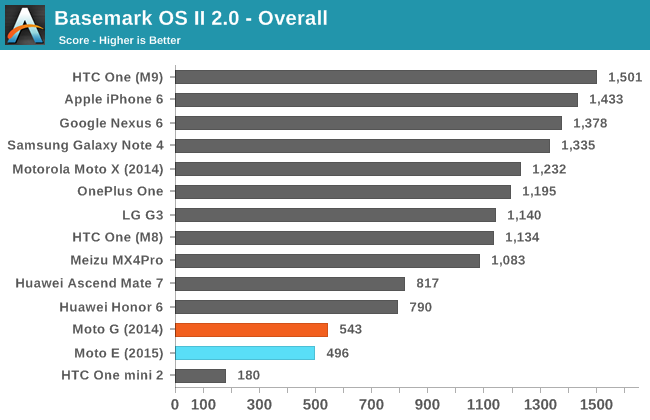
In BaseMark OS II we actually see the Moto E performing worse than the Snapdragon 400 powered Moto G. The Moto G's higher score in the memory subtest helps to give it an advantage overall, and I'm at a loss to explain why the Moto E scores 50 points lower than the Moto G in the Web subtest. I can only imagine that the cause is related to software tuning but I can't definitively say why the gap is as large as it is.
Overall the Moto E does perform well for a budget device, but I do wish Snapdragon 410 showed a greater performance uplift over Snapdragon 400. With only 1GB of RAM and a maximum memory bandwidth of only 5.3GB/s Snapdragon 410 is also under some heavy memory constraints that could be acting as a bottleneck to potentially greater performance improvements with Cortex A53 over Cortex A7.










90 Comments
View All Comments
RealTheXev - Wednesday, April 29, 2015 - link
In my mothers situation.. the fact it can even connect to the wifi is the only thing that matters. lol She will never notice the speed.serendip - Wednesday, April 22, 2015 - link
Is this the first Lenovo-fied Moto device since the acquisition? The specs and price are very underwhelming when similar low-end devices from Lenovo and Xiaomi have 720p displays, more RAM and faster SoCs. 1 GB RAM is a nightmare on Android because apps get killed and have to reload often. That's really annoying for web browsers because the content has to be downloaded again instead of being cached.serendip - Wednesday, April 22, 2015 - link
Xiaomi have really upped their game recently. Flagships have always had weekly MIUI updates but now the budget line (Redmi 1S/2/Note) are also on a weekly schedule for the developer ROM. Better late than never.As for hardware support, that's a big issue because Xiaomi officially doesn't sell outside of China and some APAC countries. You won't have a physical repair depot to turn to if you buy from an online reseller.
spiked_mistborn - Wednesday, April 22, 2015 - link
Great review. You just confirmed what I have been experiencing since I got my Moto E LTE when they first came out. Some of the initial reviews said the screen was dim and poor quality, but I have not found that to be the case, and your test backs that up. Being a recent college grad still looking for work in my field, in addition to a tech enthusiast, this phone was the best option for my budget. It works well enough that I don't mind waiting, for a long time if necessary, for that killer phone that I would actually feel is worth paying several hundred dollars for. Nothing fits that description yet IMO.One thing that I would love to see added to future reviews is network throughput speeds through a VPN. I use OpenVPN all the time for both remote file access/music streaming, and also for security on open WiFi. The OpenVPN connect client recently added support for ARMv8 crypto instructions, so it would be nice to see how everything stacks up when the speed of the internet connection is not a bottleneck. Maybe test over mobile data and WiFi? The WiFi link speed might still be the limiting factor, but if the rest of the soc is working too, such as streaming HD video, the extra efficiency from ARMv8 might be quantifiable. Qualitative differences in the video could show up as well. Maybe a battery rundown test while streaming over the VPN might show some major differences as well?
sonicmerlin - Wednesday, April 22, 2015 - link
Buy a phone used on eBay if you're on a budget. You can get last year's flagships for less than $200sonicmerlin - Wednesday, April 22, 2015 - link
What's the speed difference between Cortex A7 and A53?sasidharkareti - Friday, April 24, 2015 - link
Moto E 2nd generation has good upgrades DDR3, 8GB internal, 4.5 inch IPS, 2300 mAh, Android 5.0, front camera and 3G/4G are most welcomed.The removable bezel is a bit scary everytime it is plucked out. The battery takes a bit loger time to recharge. Besides these two, I love Moto e's performance.
Harry_Wild - Tuesday, April 28, 2015 - link
"802.11 b/g/n + BT 4.0, USB2.0, GPS/GNSS, NFC"It has NFC but no "ac" for the Wi-Fi standard!
Maverick215 - Wednesday, April 29, 2015 - link
Out of curiosity, did you test NFC performance? I ask because the arstechnica review indicates that there is no NFC capability present in this device. Likewise the specs listed on motorola.com say "NFC - No"While I'm hopeful you have some information regarding activating this hidden feature, I'm guessing this was just an error.
Jwraith15 - Sunday, September 27, 2015 - link
Bestbuy now has the Sprint Prepaid LTE VERSION for $39